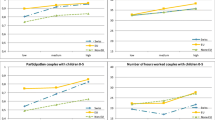Abstract
The analysis of labour supply involves two issues: whether individuals participate in the labour market and, if they do, for how many hours. In this article we investigate the differences in labour supply of married women and cohabiting women in the Netherlands; we try to answer the question how these differences can be explained. From this study, it can be concluded that differences between both categories of women in participation and in weekly hours worked can predominantly be explained by differences in characteristics (e.g. age, net wage rate, and age of children), than by differences in behaviour. The empirical results indicate that cohabiting women are more economically independent than married women. However for married women we found evidence that there was increased economic independence during the eighties; i.e. their weekly hours work has become less affected by the income of their partners.
Résumé
L'analyse de l'offre d'emploi entraîne deux questions: est-ce que les individus participent au marché du travail et, s'ils le font, pour quel nombre d'heures? Nous examinons dans cet article les différences dans l'offre dans d'emploi des femmes mariées et des femmes cohabitantes, en Hollande. Nous essayons de répondre à la question suivante: comment ces différences peuvent-elles être expliquées? Cette étude permet de conclure que les différences entre les deux catégories de femmes, portant sur la participation au marché du travail et sur le nombre d'heures de travail hebdomadaire, peuvent être expliquées en majeure partie par des différences de caractéristiques (c'est-à-dire l'âge, le salaire et l'âge des enfants), plutôt que par des différences de comportement. Les résultats empiriques montrent que les cohabitantes sont économiquement plus indépendantes que les femmes mariées. Pour ces dernières cependant nous avons mis en évidence une augmentation de leur indépendance économique, au cours des années 1980: le nombre d'heures de travail hebdomadaire qu'elles font, est de moins en moins affecté par le revenu de leur conjoint.
Similar content being viewed by others
References
Altena, R.A. van, J. Plantenga, J.J. Schippers and J.J. Siegers, 1990. Demografische Ontwikkelingen en het Functioneren van de Arbeidsmarkt: een Vergelijkende Studie naar het Overheidsbeleid in de Bondsrepubliek Duitsland, Frankrijk, Zweden en Nederland. OSA, The Hague, The Netherlands.
Dijk, L. van, A.H.E.B. Koot-du Buy and J.J. Siegers, 1993. Day-care supply by Dutch municipalities. European Journal of Population, 9: 315–330.
Feijter, H. de, 1991. Voorlopers bij Demografische Veranderingen. NiDi-rapport nr. 22, 's-Gravenhage, The Netherlands.
Heckman, J.J., 1979. Sample selection bias as a specification error. Econometrica 47: 153–161.
Henkens, K., J. Siegers and K. van den Bosch, 1993. Married women on the labour market; Belgium and The Netherlands. In: G. Beets (ed.), Population and Family in the Low Countries. Swets and Zeitlinger, NIDI/CBGS publications, nr. 23, Lisse/Amsterdam, The Netherlands, pp. 77–99.
Hoem, B., 1992. The Compatibility of Employment and Childbearing in Contemporary Sweden, Stockholm Research Reports in Demography, 59E, Stockholm University.
Killingsworth, M.R. and J.J. Heckman, 1986. Female labor supply, a survey. In: O. Ashenfelter and R. Layard (eds), Handbook of Labor Economics. Vol. 1, North-Holland, Amsterdam, The Netherlands, pp. 103–204.
Korpi, T., 1989. Women's Entry into Employment after First Birth: the Effects of Cohort/Period and Labor Force Experience, Stockholm Research Reports in Demography, 57, Stockholm University.
Liefbroer, A.C., 1991. Kiezen tussen Ongehuwd Samenwonen en Trouwen. Ph.D. Dissertation, Vrije Universiteit Amsterdam, The Netherlands.
Ministry of Social Affairs and Employment, 1985. Beleidsplan Emanicatie. Den Haag, The Netherlands.
Plantenga, J., 1993. Een Afwijkend Patroon. Honder Jaar Vrouwenarbeid in Nederland en (West-) Duitsland. Amsterdam SUA, The Netherlands.
Pott-Buter, H.A., 1993. Facts and Fairy Tales About Female Labor, Family and Fertility. A Seven-country Comparison, 1850–1990. Amsterdam, Amsterdam University Press, The Netherlands, 28.
Renaud, P.S.A. and J.J. Siegers, 1983. Het aanbod van arbeid door gehuwden. Economisch Statistische Berichten, 63(3408): 507–510.
Schippers, J.J., 1987. Beloningsverschillen tussen Mannen en Vrouwen. Ph.D. Dissertation, Rijksuniversiteit te Groningen, The Netherlands.
Social and Cultural Planning Office, 1992. Social and Cultural Report 1992, Rijswijk, The Netherlands.
Siegers, J.J., 1985. Arbeidsaanbod en Kindertal. Ph.D. Dissertation, Rijksuniversiteit te Groningen, The Netherands.
Siegers, J.J., 1984. Equality of the sexes in the distribution of labour: Is the goal in sight? Labour and Society, 9(2): 151–163.
Siegers, J.J., 1984. Uurloonverschillen tussen mannen en wrouwen en de arbeidsverdeling binnen het huishouden. Tijdschrift voor Politieke Ekonomie, 7(3): 106–114.
Wiebrens, C.J., 1981. Inkomen en Rondkomen. Social and Cultural Planning Office, Den Haag, The Netherlands.
Author information
Authors and Affiliations
Rights and permissions
About this article
Cite this article
Henkens, K., Meijer, L. & Siegers, J. The labour supply of married and cohabiting women in the Netherlands, 1981–1989. Eur J Population 9, 331–352 (1993). https://doi.org/10.1007/BF01265642
Received:
Revised:
Issue Date:
DOI: https://doi.org/10.1007/BF01265642




